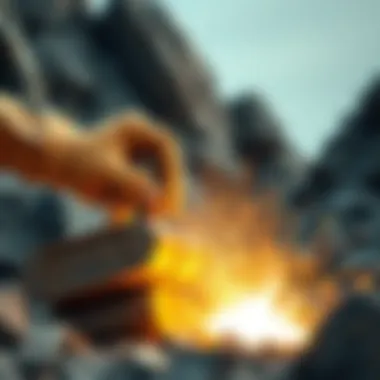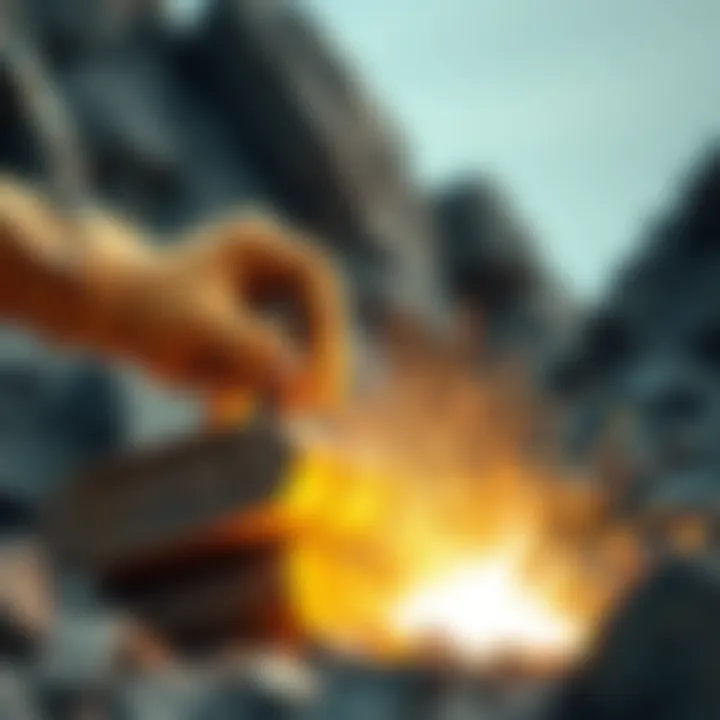Effective Techniques for Breaking Boulders Safely


History and Origins
Boulders have captivated human interest for centuries. Their immense size and weight can evoke feelings of awe and curiosity. Early cultures utilized these natural formations for both practical and mystical purposes. From Ancient Egypt, where large stones were quarried to construct pyramids, to the Stonehenge in England, boulders have been integral to human history. This section provides a deeper dive into how our ancestors interacted with these incredible geological features.
Overview of Collectibles, Rocks, and Fossils
When we discuss breaking boulders, it's crucial to consider their broader relationship to collectibles and fossils. Many enthusiasts find beauty not just in gem-quality stones, but also in the history embedded within layers of sediment and rock formations. Collectors often seek specific fossils or geological specimens that tell a story.
Rocks and fossils serve as windows into our planet's past, revealing information about the environment from eons gone by. The ability to crack open a boulder and reveal pristine crystal formations or bones is a blend of artistry and science.
"Every boulder is a chapter of Earth's history; when broken open, it whispers secrets of the past."
Historical Significance and Cultural Impact
Boulders and stone have not only shaped landscapes but also influenced cultures. Indigenous peoples often regarded massive rock formations as sacred, believing they held spiritual significance. For example, the Anishinaabe people view boulders as markers of their history, telling stories of creation and ancestry. In contemporary times, many artists sculpt from boulders, transforming raw stone into vibrant works of art that convey emotion and form.
Through these perspectives, we find that the act of breaking boulders transcends mere physical activity; it is intertwined with the very essence of human culture and expression.
Identification and Classification
To effectively manage and break boulders, one must first understand their composition. Each type of rock has distinct characteristics that influence how best to approach breaking them. Here's a guide to identification and classification that can inform techniques.
Guide to Identifying Rocks and Fossils
Most boulders can be categorized broadly into igneous, sedimentary, or metamorphic types. Each of these categories has unique features:
- Igneous Rocks: Formed from cooled magma, these can be very hard. Examples include granite and basalt.
- Sedimentary Rocks: Created from the accumulation of sediments, they often contain fossils. Sandstone and limestone fall into this category.
- Metamorphic Rocks: These are transformed from existing rock due to high pressure and heat. Notable examples are marble and schist.
Understanding these different types will allow collectors and landscapers to select appropriate tools and techniques.
Common Types and Variations
Within the broad categories, there are numerous variations:
- Granite: Resistant to weathering, often used in construction.
- Slate: A metamorphic rock used for roofing and flooring, can flake into thin layers.
- Limestone: Commonly used in landscaping, it can dissolve in acidic conditions.
Identifying specific boulders is integral not just for breaking them effectively, but also for potential collectible value. Enthusiasts often value rare formations for unique patterns, colorations, or fossil inclusions that tell a story of ancient ecosystems.
By appreciating the historical context and identifying the rock types, one can approach the practice of breaking boulders with a blend of respect and intention.
Understanding the Composition of Boulders
The cornerstone of effectively breaking boulders lies in the understanding of their composition. Boulders, the giant stones we often encounter in nature, are primarily made up of various types of rocks. These rocks possess distinct physical and chemical properties, which can significantly influence the methods used for breaking them apart.
Knowing what a boulder is composed of not only helps in choosing the right technique for breaking it, but it also ensures safety and efficiency during the process. For instance, some rocks are denser and harder, while others may have high porosity, affecting how tools and chemicals interact with them. Thus, gaining insight into the different physical properties and rock types aids enthusiasts and professionals alike in their endeavors to manage and manipulate these large formations.
Physical Properties of Rocks
Density
Density refers to the mass per unit volume of a rock, and understanding it is paramount when considering how to break boulders. Denser rocks, like basalt, require more force to break compared to less dense varieties like sandstone. This means that the tools chosen for breaking dense boulders must be robust and powerful, like hydraulic equipment.
The key characteristic of density is that it indicates how substantial a rock is, which is crucial when evaluating potential techniques. A beneficial aspect of density in this context is that it helps in forecasting the challenges one might face. Higher density rocks may lead to increased wear and tear on tools, thus requiring careful planning and consideration of expenses related to tool maintenance and replacement.
In summary, density is a fundamental aspect that can directly impact the effectiveness and efficiency of breaking boulders.
Hardness
Hardness measures a rock's resistance to scratching and abrasion. This property is essential to assess when selecting tools for breaking boulders. Harder rocks, such as granite, demand specialized tools like diamond-tipped drills or chisels, while softer rocks can often be handled with simpler tools.
A key characteristic of hardness is the ability to delineate how much force is necessary to cause a fracture. Rocks with high hardness can significantly slow down progress if inappropriate tools are used. A notable advantage of understanding hardness is that it offers a roadmap for optimizing the equipment used in the task ahead.
One disadvantage, however, is that it poses a learning curve; misjudging hardness can lead to tool failure or injury. Therefore, acknowledging hardness is pivotal in planning for any boulder breaking endeavor.
Porosity
Porosity is the measure of void spaces in a rock, and it has notable implications when working with boulders. It affects water retention and the overall structural integrity of the rock. Higher porosity can lead to a weaker structure, making it easier to break using various methods. For example, porous sedimentary rocks like limestone can often be fractured more easily due to the presence of internal voids.
A primary characteristic of porosity is that it can indicate how water interacts with the rock. Understanding porosity offers the ability to identify opportunities for utilizing water-based expansion techniques.
Yet, this feature has its caveats; in some cases, high porosity could lead to the presence of fractures that weaken the rock unpredictably, creating challenges. In essence, porosity is a vital aspect to consider for its potential benefits and pitfalls in breaking boulders.
Types of Rock
Boulders consist of different types of rocks, each of which brings unique attributes to the table.
Igneous
Igneous rocks form from cooled magma or lava and are often known for their strength and durability. Their crystalline structure can often make them difficult to break without the right techniques. One significant aspect of igneous rocks is their hardness, which means that power tools or heavy-duty chiseling methods may be necessary for effective breaking.
Another key characteristic is the wide spectrum of varieties present, from basalt to granite. Their diversity might offer collectors unique specimens, however, the challenge is associated with selecting an appropriate breaking method based on the specific type encountered.
Sedimentary
Sedimentary rocks are generally formed from the accumulation of sediments, and they can exhibit various levels of hardness based on their composition. Common examples include limestone and sandstone. Their layered structures can often dictate how they break – softer sedimentary rocks may fracture more easily under pressure compared to others.
A compelling quality of sedimentary rocks is their rich fossil content, making them popular among collectors. However, their variable strength can mean that techniques that work for one boulder may not work for another, necessitating careful assessment of each site's characteristics.


Metamorphic
Emerging from changes in pressure and temperature, metamorphic rocks like schist or gneiss can pose unique challenges. Their denser and often tougher composition means breaking them usually requires a more sophisticated approach. They can sometimes boast beautiful patterns that attract collectors.
An interesting feature of metamorphic rocks is their formation history, which might pique the interest of enthusiasts when considered in the context of geological processes. Still, their rugged nature can also lead to frustration during breaking attempts, highlighting the importance of being well-prepared for such endeavors.
Safety Precautions
When it comes to breaking boulders, safety cannot be overstated. It’s not just about getting the job done; it’s about ensuring that you—yourself and everyone around you—stays safe. The process of breaking rocks for various applications, from landscaping to geological studies, comes with its own set of risks. Therefore, taking the right precautions can make all the difference. By implementing safety measures, we reduce the risks associated with accidents, such as injuries from falling debris or improper handling of tools. Moreover, being diligent about safety can help maintain a controlled environment, allowing for a more efficient workflow.
Protective Gear
Protective gear is the backbone of any safe rock-breaking operation. Each piece serves a specific purpose, and neglecting them could lead to dire consequences.
Gloves
Gloves are essential when breaking boulders. They provide not just grip but also protection against sharp edges and rough surfaces. High-quality gloves made from durable materials like leather or synthetic fibers can withstand the wear and tear of handling tools and boulders. The key characteristic of good gloves is their ability to be both protective and flexible. Opting for gloves with reinforced fingertips can offer additional protection where it counts the most. However, it’s worth noting that thicker gloves can sacrifice some dexterity, potentially making it more difficult to handle smaller tools or perform delicate tasks.
Eye Protection
Eye protection is another critical component of safety gear. When breaking boulders, fragments and dust can fly up unexpectedly, causing serious eye injuries. Safety glasses or goggles with side shields are beneficial as they offer complete coverage. They should meet safety standards set forth by organizations like the American National Standards Institute (ANSI) to ensure reliable protection. The unique aspect of modern eye protection is the availability of anti-fog and anti-scratch coatings, enhancing visibility and longevity. However, some wearers find that these glasses may become uncomfortable over time, particularly during long work sessions.
Helmet
Wearing a helmet might feel cumbersome at times, but when it comes to safety, it's a non-negotiable tool. A hard hat protects against falling debris, which is a significant risk when breaking down larger rock structures. Helmets specifically designed for construction work offer features such as ventilation and adjustable fittings. The special characteristic here is the lightweight nature of many helmets today, making them easy to wear for extended periods without discomfort. Still, it’s crucial to ensure the helmet fits well; if it's too loose, it won’t provide adequate protection during an accident.
Site Assessment
Before breaking boulders, a thorough site assessment is imperative. This evaluation helps identify potential hazards and gauge the area’s stability, which is key to an accident-free workspace.
Identifying Hazards
Identifying hazards involves a keen eye for the environmental elements that could pose risks. This means looking out for loose rocks, unstable ground, and other potential dangers that could lead to injuries. A common practice is to conduct a walk-through of the area before starting the job. This proactive approach allows one to devise strategies for managing risks effectively. However, some might overlook the subtle signs of instability, thus underscoring the need for comprehensive training on hazard recognition.
Assessing Stability
Assessing stability is all about evaluating the boulders and the surrounding terrain. Is the rock formation stable enough to break? Are there signs of movement that could result in a collapse? It's vital to consider geological factors such as soil erosion or water drainage that may undermine the area. A stable site contributes to effective boulder-breaking techniques and minimizes the risk of sudden rockfalls. While visual assessments are often sufficient, employing tools like inclinometers can provide precise measurements of slope stability.
"Safety is a priority; overlooking it can turn a productive day into a dangerous one."
In summary, adhering to safety precautions not only protects you but also lays the groundwork for a successful boulder-breaking endeavor. With the right protective equipment and a careful assessment of your work area, you can tackle rock formations with confidence.
Mechanical Techniques for Breaking Boulders
Understanding the mechanical techniques for breaking boulders is crucial for anyone involved in geology, landscaping, or construction. Using the right mechanical methods not only speeds up the process but also reduces the risk of damage to the area around the boulders. Additionally, mastering these techniques translates into increased efficiency and productivity. With mechanical tools, workers can leverage human power, enhanced by tools, to make short work of seemingly insurmountable rock formations.
The importance also lies in the range of applications; whether it’s for landscape beautification or geological research, knowing how to break boulders safely and effectively makes a notable difference. These mechanical techniques provide tangible benefits, such as precision and control, allowing for better results with minimal disruption.
Using Hand Tools
When it comes to breaking boulders, hand tools provide a classic, hands-on approach to the task. They offer a higher degree of control and also require less setup compared to powered equipment. This makes hand tools a popular and beneficial choice for many collectors and hobbyists who prefer a more traditional method.
Hammers and Chisels
Hammers and chisels have been used for centuries in various forms of rock work. The primary purpose of chisels is to create fractures in boulders, while hammers deliver the necessary force to accomplish this.
One of the remarkable aspects of using hammers and chisels is their simplicity. They are not only cost-effective but also require minimal maintenance. Wooden-handle hammers, for example, offer a classic feel, while metal chisels have a strong edge that can penetrate rock effectively. However, it can demand considerable effort and skill to execute effectively.
Advantages of Hammers and Chisels:
- Control: Offers finer precision while aiming at specific areas.
- Cost: Generally more affordable than power tools.
- Portability: Easy to carry and use in remote locations.
Disadvantages include:
- Labor-Intensive: It requires physically demanding effort and can become exhausting.
- Limited Efficiency: More time-consuming than power tools for larger boulders or higher quantities.
Pry Bars
Pry bars, on the other hand, are invaluable when dealing with heavy rocks. Their design allows for greater leverage, letting users apply a significant amount of force with relatively less physical effort.
A key characteristic of pry bars is their length and strong metal construction. They are capable of shifting boulders or wedging into cracks to create movement. This makes them ideal if you're looking at breaking boulders that might not be easily accessible with just hammers and chisels. While they might not break the rocks directly, they manipulate and move them into a manageable position.
Advantages of Pry Bars:
- Leverage: Invaluable for moving heavy boulders or manipulating them for easier access to breakage.
- Durability: Crafted to withstand the stresses of prying and bending effectively.
Disadvantages include:
- Skill Required: Effective use depends on understanding mechanics of leverage and effort.
- Weight: Some pry bars can be relatively heavy, making transport challenging.
Power Tools
In the realm of breaking boulders, power tools have become vital due to their speed and efficiency. These tools come into play especially when dealing with larger rocks or if time constraints exist.
Jackhammers
Jackhammers are highly effective when it comes to large-scale rock breaking. These machines deliver rapid hammering action directly onto the rock surface, allowing it to fracture under pressure. The high-frequency vibrations generated help in breaking the bonds within the rock material.


One key advantage of jackhammers is tremendous power. When operated correctly, they can take tasks that would normally require hours and reduce them into mere minutes. Additionally, there are various attachments available, making them versatile tools suitable for different types of rock work.
Advantages of Jackhammers:
- Efficiency: Dramatically reduces time spent breaking large rocks.
- Versatility: Can accommodate various attachments for different jobs.
Disadvantages include:
- Noise: They can be very loud, often needing ear protection.
- Skill: Effective use requires training and practice due to the control needed to manage vibrations.
Stone Splitters
Stone splitters offer a specialized solution that comes into play particularly in landscaping and construction contexts. These tools apply pressure evenly across a rock surface. Their functionality mimics the force generated by natural geological processes, providing a controlled and clean split on the boulder.
Unique features of stone splitters include their hydraulic action, which allows for breaks with minimal effort. Many modern varieties include features that enhance safety and any required setup minimizes effort. Additionally, stone splitters are perfect for shaping boulders for aesthetic or structural purposes.
Advantages of Stone Splitters:
- Precision: Provides accurate cuts and splits.
- Reduced Labor: Quieter and less physically demanding than other methods.
Disadvantages include:
- Cost: Can be expensive and may require maintenance due to hydraulic systems.
- Setup Time: Requires preparation time, making it less spontaneous than hand tools.
In summation, both mechanical and power tools each offer a distinct set of benefits tailored to the needs of breaking boulders. By choosing the appropriate technique based on the circumstances, individuals can enhance productivity while also ensuring safety and efficiency in their work.
Chemical Techniques for Breaking Boulders
Chemical techniques represent a remarkable method for breaking boulders, especially when traditional mechanical approaches fall short. These techniques tend to be quieter and often less labor-intensive than hammering or chiseling. Moreover, chemical approaches offer efficiency in certain situations, particularly where precision is crucial or where the integrity of surrounding materials must be preserved. It's vital to be aware of the specific elements to consider, including effectiveness, safety, and environmental impact, when deciding on employing chemical options.
Expansive Agents
How They Work
Expansive agents are fascinating compounds that, upon hydration, undergo a significant increase in volume. Typically made from a mixture of cement-like materials, these agents function on a principle that allows them to exert pressure within the cracks of a boulder over an extended period of time. As they expand, they create substantial internal stress, leading the rock to fracture along its natural seams. This unique characteristic makes them popular for those looking to work with larger obstacles in a controlled manner.
While they can be incredibly efficient, care must be taken not to overapply them, as this can lead to unpredictable cracking patterns. Therefore, understanding the specific expansive properties and how they interact with different rock types is key to successful implementation.
Application Methods
Applying expansive agents requires careful preparation and technique to ensure effectiveness. This generally involves drilling holes into the boulder, where the agent is then introduced. Once the mixture is in place, water is added, triggering the hydration process. This straightforward technique makes it an approachable choice for novices and experienced collectors alike. However, a significant aspect to note is that the timing between application and the expected cracking can vary, necessitating patience and punctual assessments of the situation. Some may find the slower process to be a drawback; however, others appreciate the meticulous control it affords in managing how the boulder is handled.
Hydraulic Agents
Working Mechanism
Hydraulic agents leverage the properties of water and pressure to break apart boulders. Upon applying these agents, water typically seeps into crevices or drilled holes, creating pressure that forces the rock to yield. The simplicity of this approach is a massive draw for many, as one doesn’t need to rely on heavy machinery or extensive training to utilize hydraulic power effectively. A key element of hydraulic agents is that they may allow for varying degrees of control in fracture direction, depending on how they are positioned within the rock. Thus, understanding focal points is essential.
Benefits and Drawbacks
The benefits of using hydraulic agents include minimizing the labor intensity and avoiding the loud noise associated with hammering or chiseling. These agents are often praised for their efficiency and minimal risk of injuring workers or damaging nearby structures. However, one must also remember that the effectiveness of hydraulic agents may be highly reliant on site-specific conditions, including moisture content and rock porosity. This can sometimes limit their use in arid environments, where water scarcity may be a concern. In contrast, while hydraulic agents can provide substantial efficacy, they may require a more comprehensive understanding of the geology involved to maximize their potential.
Environmental Considerations
When breaking boulders, the interaction with local environments cannot be overlooked. Techniques employed in this endeavor can significantly affect ecological systems and existing habitats. It's crucial to approach these activities with awareness, focusing not only on the methods of breaking boulders but also on the broader implications for the environment. This section outlines the impact on local ecology and the necessities of adhering to regulations while minimizing harm.
Impact on Local Ecology
Habitat Disruption
Habitat disruption occurs when local wildlife and plant life are impacted by the physical processes involved in breaking boulders. For instance, the removal of boulders could destabilize nearby soil, leading to erosion and potentially harming the habitats of various creatures. This disruption is particularly critical in areas where rare species reside or where delicate ecosystems are at play.
One key characteristic of habitat disruption is its immediate effect on biodiversity. When a boulder is fractured or removed from its location, the sudden change can lead to loss of species that rely on the stability of that rock environment. Birds that nest in or on boulders, for instance, may abandon their young if the landscape changes too drastically. Thus, understanding this aspect provides insight into why preserving natural environments is fundamental while carrying out rock-breaking endeavors.
However, the advantage of recognizing habitat disruption is that it allows collectors and workers alike to consider alternative approaches that could minimize adverse effects, such as timing excavation efforts during seasons of low wildlife activity.
Minimizing Damage
Minimizing damage refers to the practices put in place to lessen the footprint left during rock-breaking procedures. This can include strategies such as using targeted chemical applications to carefully break boulders rather than using heavy machinery that might cause collateral damage. The essence of minimizing damage lies in seamlining efforts to ensure that only the boulders intended for breaking are affected while safeguarding the surrounding environment.
A key characteristic here is the planning involved. By assessing the area beforehand and determining the best approach to minimize disruption, individuals can preserve essential aspects of the local ecology. This is a beneficial approach because it not only protects the environment but also fulfills any legal requirements that prioritize ecological preservation. The use of biodegradable agents in specific applications also represents a thoughtful way to proceed without incurring long-lasting detriments to soil or plant health.
Some unique features of minimizing damage include employing methods that focus on the efficient use of energy and tools, preventing wasteful practices that harm surrounding flora and fauna. Despite these advantages, it's imperative to recognize the disadvantage that the need for meticulous planning may require additional resources and time.
Regulations and Permits
Understanding local laws and requirements is essential for anyone involved in the process of breaking boulders. These regulations are established to protect both the environment and the individuals performing these activities. Understanding what is legally allowed can guide collectors and contractors to conduct work smoothly and ethically.
Local Laws
Local laws dictate what can and cannot be done in terms of breaking boulders. This includes regulations about where excavation can occur, restrictions on timings, and specific methods that are prohibited due to their ecological impact. The importance of local laws cannot be overstated; they play a crucial role in ensuring that rock breaking does not detrimentally affect both nearby ecosystems and public safety.
Highlighting the key characteristic of these laws is their adaptability. Many areas strengthen regulations based on ecological assessments or seasonal patterns of wildlife, reflecting a proactive stance towards environmental protection. This makes understanding local regulations a beneficial choice for anyone who wishes to prevent legal repercussions while also preserving delicate natural habitats.
Unique aspects of local laws may include requirements for permits that specifically highlight the techniques and tools being used. While necessary, obtaining permits can sometimes be cumbersome for individuals or small groups who are simply trying to pursue rock collection as a hobby rather than a full-scale operation.
Best Practices for Compliance
Best practices for compliance revolve around the strategies individuals can implement to adhere to local regulations effectively. Developing an understanding of these practices ensures that all activities related to breaking boulders are conducted within the legal framework, while also attending to environmental considerations. All actions—from planning to execution—should reflect a commitment to safeguarding the ecological integrity of the area.


One key characteristic of these practices is thorough documentation. Keeping detailed records of permits acquired, ecological assessments conducted, and methods employed can shield collectors and workers from potential fines or legal issues. This aims to cultivate a beneficial relationship with local authorities, promoting transparency and cooperation.
Furthermore, these best practices often include a commitment to ongoing education regarding local ecology. Attending workshops or community meetings can foster better understanding and compliance. A unique feature of this commitment to education is that it encourages a culture of shared knowledge among collectors, which can lead to more innovative and environmentally friendly techniques.
Practical Applications in Collecting
When it comes to breaking boulders for collecting purposes, understanding the practical applications is crucial. This sector intertwines skill, safety, and an appreciation for geology that many enthusiasts and professionals share. Proper techniques not only enhance the value of specimens but also honor the surrounding environment. Knowledge of various methods can lead to successful outings, whether for personal collection or academic research.
Preparing Specimens for Collection
Identifying Value
Identifying value in rock specimens can be the difference between mining for treasures or just wasting time. Recognizing what makes certain rocks unique can enhance a collector’s portfolio considerably. Gypsum, for example, may look plain but could have fibrous forms like selenite that captivate a buyer's attention. Not all specimens are created equal; some may have intrinsic mineral properties that significantly boost worth.
Its critical feature is rarity and aesthetic appeal. The complexity of the formation process often translates to higher demand among collectors. However, value identification holds its risks too. For instance, relying solely on unverified expertise might lead to poor purchases or misjudgments in worth.
Cleaning Techniques
Cleaning rocks post-collection is an integral step in highlighting their beauty. It’s like giving them a fresh coat of paint—newly revealed colors and textures can jump out at you. Utilizing water and soft brushes is a well-known method. Not only does this technique preserve the rock’s natural beauty, but it also avoids the risk of damaging delicate surfaces.
The clean nature of this method is one of its strong points. Effectively enhances appearance without harsh chemicals that could compromise mineral integrity. Still, there's a flip side. Certain stains or heavy dirt might require more intense cleaning agents, which could impact the specimen's value or stability over time.
Transporting Breaks
Choosing the Right Vehicle
Transporting collected boulders demands careful consideration of the vehicle in use. It’s essential to go for options designed to handle heavy loads, like a pickup truck or a flatbed carrier. A sturdy vehicle not only ensures safety for the specimen but also protects the driver from potential accidents with shifting cargo.
The hallmark of choosing the right vehicle lies in its weight capacity and space configuration. Well-suited vehicles allow for strategic placement of large boulders, minimizing movement during transport. However, one must keep in mind that not all vehicles can handle bulk, so underestimating load can lead to serious trouble down the road.
Securing Cargo
Once the right vehicle is selected, securing the cargo is the next step. Using robust tie-downs or netting can ensure the boulders remain where they should—right in the bed of your truck. The main feature of a well-secured load is stability, which prevents damaging the rocks or the vehicle itself during transport.
Another advantage of proper securing techniques is peace of mind. Knowing your precious finds are safe means one can focus on the journey rather than potential damage. However, neglecting to secure correctly can result in loose loads leading to accidents or, worse, loss of valuable specimens.
The suggestions provided align with a larger landscape: breaking boulders isn't simply about the act of breaking them; it’s about understanding their value and handling them with the care they deserve.
Case Studies
Exploring case studies in the context of breaking boulders reveals a wealth of knowledge that extends beyond mere techniques. These studies serve as a window into the application and evolution of methods used historically and contemporarily, showcasing how practices resonate within different contexts. By analyzing particular cases, we can uncover not only the practical aspects of breaking boulders but also the societal impacts and innovations that these examples embody.
Historical Methods
Ancient Techniques
Ancient techniques for breaking boulders reveal much about the ingenuity of early human societies. One prominent method involved the use of fire-setting, where controlled fires would be lit on rock surfaces. The thermal shock from heating and subsequently dousing the rock in water would lead to fractures. This method is notable for its simplicity and effectiveness; the fire didn't require advanced tools, making it accessible to early humans. However, it had significant drawbacks, including the need for careful management of fire, which could lead to dangerous outbursts if left uncontrolled. Moreover, the approach is limited by the type of rock and environmental conditions. Yet, this method illustrates how even without modern technology, humans found ways to manipulate and utilize their environments effectively, setting the stage for future techniques.
Modern Adaptations
In contrast, modern adaptations improve upon ancient methods by integrating technology and advanced materials. For instance, the introduction of explosives tailored for controlled demolition has revolutionized the field. Such explosives allow for precision that ancient techniques lacked, making it possible to break boulders in densely populated areas or sensitive environments. This method also emphasizes the importance of safety protocols, as improper use can lead to significant hazards. Despite its strengths, reliance on these methods raises concerns regarding environmental impact, particularly if not executed with care. Thus, while modern adaptations offer tools that enhance efficacy, they also bring challenges that must be navigated responsibly.
Contemporary Practices
Landscaping
In the realm of landscaping, breaking boulders takes on a different dimension. The focus here is not just on removal but on integrating stones into design, creating natural aesthetics and functional spaces. Effective boulder placement can promote drainage, provide wildlife habitats, and enhance visual appeal in gardens or parks. However, the techniques employed must be thoughtful to avoid unintentional harm to the surrounding flora and fauna. The careful incorporation of boulders can lead to stunning results, but requires an understanding of ecology and design principles, highlighting the necessity of a multidimensional approach to rock manipulation.
Construction Projects
Similarly, construction projects often involve breaking boulders to facilitate foundations and infrastructure. Traditionally, rock drillers and jackhammers were employed, but advances have introduced more sophisticated machinery that optimizes efficiency and minimizes noise and dust. For instance, diamond wire saws provide precise cuts, significantly reducing waste and enhancing sustainability. However, these methods also demand skilled operators and strict adherence to safety measures. As construction evolves, it is essential to balance the demand for progress with environmental considerations and community impacts. By examining the case studies spanning both historical and contemporary practices, one gains insights into the dynamic interplay between technique, technology, and environmental consciousness, leading to a more holistic understanding of breaking boulders.
Understanding these case studies not only equips rock and fossil collectors with knowledge but also instills an appreciation for the evolving relationship between humans and the natural world.
Future Trends
Understanding future trends in breaking boulders is vital for anyone involved in geology, construction, or landscaping. As techniques and technologies evolve, they not only streamline the process but also offer safer and more efficient means of handling large rock formations. These trends often focus on augmenting the capabilities of traditional methods while addressing modern challenges, such as environmental impact or worker safety.
Advancements in Technology
Automation
Automation plays a significant role in revolutionizing the traditional methods of breaking boulders. The integration of robotics and advanced machinery has transformed the landscape of rock handling and excavation. A key characteristic of automation is precision; robotic systems can adhere to exact measurements and sytematically execute tasks with minimized human error. This makes automation a highly beneficial choice within this context.
The unique feature of automated systems is their ability to operate in hazardous conditions, thus reducing the risk to human workers. While this represents a substantial advantage, some downsides exist, such as initial investment costs and the need for ongoing maintenance and updates to the technology. Nevertheless, the long-term benefits, like increased efficiency and reduced labor costs, often outweigh these challenges.
Eco-Friendly Solutions
Eco-friendly solutions are becoming increasingly important in the conversation around boulder breaking. The emphasis on sustainability now pushes practices towards materials and methods that greatly reduce environmental impact. The key characteristic here is their alignment with environmental conservation efforts, making them particularly appealing. For example, using biodegradable chemical agents instead of harsh chemicals could be a beneficial approach.
Among their unique features, eco-friendly solutions focus on using natural or less toxic alternatives, ensuring that local ecosystems are preserved during excavation processes. However, one must weigh potential disadvantages, such as the effectiveness of these solutions compared to traditional methods. How well they work can sometimes depend on the specific rock types or local regulations, which may not always align seamlessly with eco-friendly choices.
Community Initiatives
Collaborative Projects
In today’s world, collaborative projects stand out as a key approach for tackling the challenges associated with boulder breaking. These initiatives often involve partnerships between local governments, non-profits, and community volunteers to enhance boulder management. A highlight of these projects is their community-driven focus, providing a platform for sharing expertise and resources. This cooperative spirit enables the pooling of knowledge that benefits the entire community.
The unique aspect of collaborative projects is their ability to create shared values around boulder management while often boosting community engagement. However, the downside may lie in the complexity of coordinating multiple stakeholders, which can sometimes lead to confusion or conflicts in objectives. Still, the advantages, such as stronger community ties, outshine the hassles involved.
Educational Workshops
Educational workshops serve as an important component in fostering a deeper understanding of techniques for breaking boulders. These workshops provide hands-on experience along with theoretical knowledge, making them invaluable for both amateurs and professionals. A defining feature is the interactive learning environment, which allows participants to engage actively in the process rather than passively receiving information.
These workshops can also highlight current trends and techniques, ultimately bridging the gap between theoretical concepts and real-world applications. Yet, they can be resource-intensive to organize, requiring significant time and effort. However, the knowledge shared can be transformative for participants, as it empowers them with essential skills and insights.



